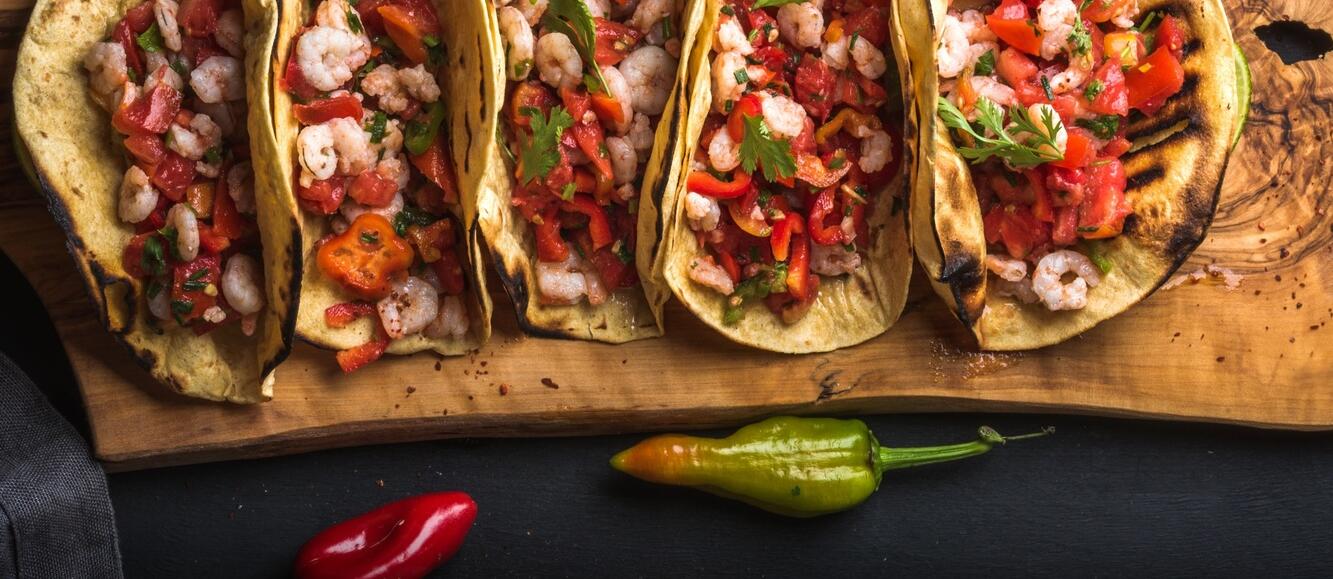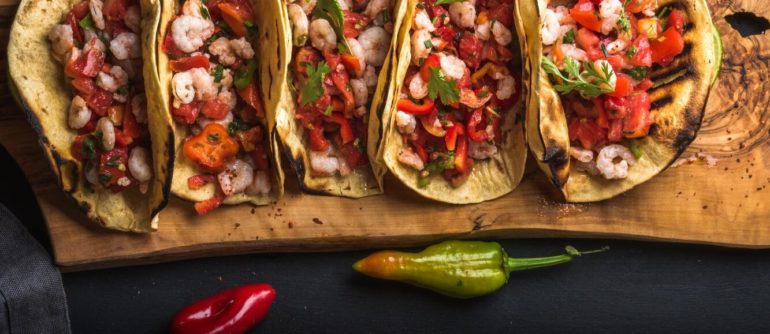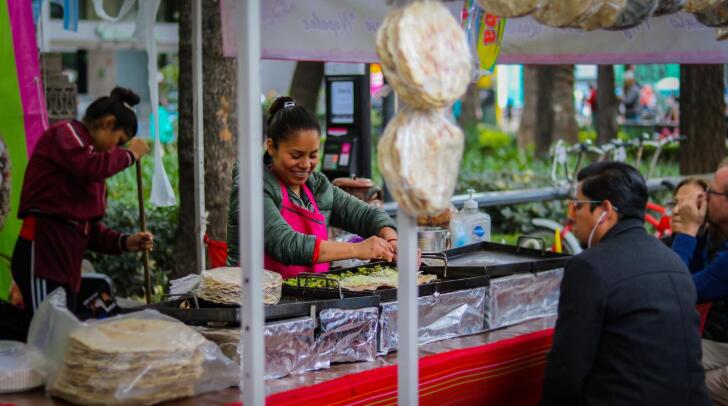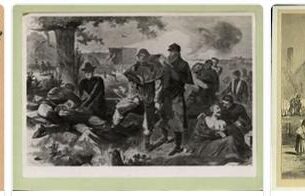Mexico is a great country with a long history and one of the world’s oldest civilizations. The country is elongated and has a great variety of climates. It encompasses everything from high mountains, volcanoes and desert, to Caribbean beaches and tropical rainforests. In the country both cereals such as corn, wheat, many kinds of vegetables and fruits, cocoa, sugar and coffee are grown. Mexico is divided into 31 states and a federal entity. Estados Unidos Mexicanos is the official Spanish name.
Mexican food is characterized by great variety and creativity in the use of ingredients, with colorful dishes and a wide range of tasting experiences.
What many people often call Mexican food, such as tacos with spicy ground beef, is texmex. Texmex is a mixture of the names Texas and Mexico, and denotes a food culture from Texas in the United States with inspiration from, among other things, North Mexican cuisine and traditions preserved from the time the state of Texas was part of Mexico.
Mexican food is one of the world’s most widely used cuisines. Traditional Mexican cuisine has since 2010 been declared a UNESCO conservation heritage.
Markets
The markets are an important part of Mexican food culture. Here you will find fresh ingredients such as fruits, vegetables, cereals, fish and meat. The market is often both a trading place and a social meeting place. You also come here to find inspiration, buy snacks, fruit or light snacks along the way on the shopping trip, learn about and taste new ingredients and exchange recipes. Both restaurants and private households prefer to go to the markets to find the best of the season’s ingredients when cooking.
As in many countries with traditions for food markets, these also face some competition from supermarkets, but in many places in Mexico the markets are still very viable and relevant. La central de Abasto in Mexico City is the world’s largest food market.
Ingredients
In Mexican cuisine, a wide range of ingredients are used for combinations of flavors, colors and a complex nutritional content. In sauces, like the many varieties of mole, you can, for example, use different types of flowers, cactus leaves, lime and other fruits, countless varieties of chili, nuts and cocoa.
Among the most typical ingredients are avocado, lime, red and green tomatoes, chili, nopales (cactus leaves), beans, pumpkin, squash, onion, tuna (cactus flower), mango, jicama, vanilla, cocoa, coriander, parsley and a wide variety of herbs. Corn has been central to Mexican cuisine ever since pre-Columbian cultures thousands of years back in time. Cheese in many varieties, nuts and rice are also important ingredients. Arroz con leche (Spanish, rice with milk), a kind of rice pudding, is a widely used dessert.
Meat, poultry, eggs, fish and shellfish are widely used, of which chicken, pork, turkey and cattle are popular. With long coastlines on both sides, the country has a diversity of species and long traditions for fish and seafood preparation.
Chile ( Spanish, plural ) encompasses a wide range of varieties, from sweet to very strong, and includes both the varieties that in Norwegian are called bell peppers and less dried varieties which in Norwegian are called chili.
Typical dishes
Moles, sauces, come in many different varieties. Homemade mole is among Mexican chefs’ greatest art, and the various varieties can be made with ingredients such as chili, seeds, spices, cocoa and much more. The most famous are the mole poblano, originating from Puebla, and the mole negro from Oaxaca. Mole is made for meat, fish, chicken and vegetarian dishes in many combinations.
Light meals, street food and snacks, ” antojitos”, are found in diversity and can be, for example, small soft maistacos with different fillings and spices, quesadillas, round cornsticks filled with cheese, or nopales fritos, fried cactus leaves. Bowls with green and red sauce, salsa verde and salsa roja respectively, lime boats and salt are always available as accessories, and also bowls with chopped coriander and parsley. In Norway, many people know about guacamole, a cold avocado-based thick sauce.
Tortilla dishes, not to be confused with Spanish omelets of the same name, are made in many varieties in Mexico, such as enchiladas, flautas, chilaquiles, or tacos al pastor. The tortilla is primarily made from maize with yellow color, but they are also based on maize varieties in blue-green color. Wheat tortilla is made mostly in the northern states and used mostly in tex-mex.
Tamales are banana or corn leaves that are filled with meat, chicken or vegetables, mixed with a special corn-based dough, masa, preferably cheese, and various spices, and cooked or steamed. Tamales are made throughout the country and are considered one of the most typical Mexican dishes. They can be enjoyed separately as street food, in smaller varieties for breakfast, or with more accessories such as dinner. Tamales has been made for thousands of years, but historians are arguing about where the court was first invented.
Soups Caldos, cremas and sopas are different hot soups. ” Chicken Callo “, chicken soup, has been used for both food and medicine for many years, and has been widely adopted by, among others, Americans as a typical relief against colds.
Other typical dishes include the classic cochinita pibíl from Yucatán (juicy elongated pork with citrus sauce), the soup / casserole pozole in regional varieties, the tortilla soup sopa azteca, chile relleno (stuffed bell pepper) and chiles en nogada, stuffed chilli bacon / paprika with pomegranate seeds and parsley.
Fish and shellfish are prepared in myriad varieties; grilled, boiled, fried, steamed, in pots, marinated in citrus fruits, etc. Popular fish dishes are, for example, pescado a la veracruzana (from Veracruz), and ceviche, raw lime-marinated fish. Most historians agree that ceviche originated in Peru. Mexican ceviche varieties are cooked slightly differently than the Peruvian and are often somewhat stronger in taste as well.
Desserts and sweets In Mexican cuisine, flan, caramel pudding is a popular dessert. Arroz con leche, rice cooked in milk with raisins, cinnamon or other spices is widely used. Dessert in Mexican can be anything from healthy fruit salads to deep-fried churros or cookies and other pastries dipped in dark chocolate.
For the celebration of Día de los muertos, the Day of the Dead, marzipan and sweets are shaped like skeletons, skulls and other glitteringly decorated figures.
Fruit in food and drink
Mexico has many warm climate zones and in the country a variety of tropical fruits such as mango, papaya, guava, melon and peach are grown and grown. Also, there are many fruit types you may not have seen elsewhere; like chicozapote, mamey and tejocote.
Mango, papaya or melon cut up artistically served with lime juice and chili, for a mix of sweet and spicy, characteristic of fresh flavors in Mexican cuisine.
History
Mexico is one of the oldest civilizations in the world, and Mexican cuisine has a rich and multifaceted history.
In pre-Columbian times, before the Spaniards discovered and colonized the country, the cuisine of the Olmecians, Aztecs and other Native American cultures was largely based on fruits and vegetables, as well as hunting and fishing. The Aztecs had vegetables and fruits such as corn, avocado, beans, chili, tomatoes, cocoa and plant growth as an important part of their diet.
When the Spaniards colonized Mexico in the 16th century, they introduced cattle, pigs and dairy products, as well as some spices from Asia, including coriander. In addition, they brought with them new cooking methods, such as cooking the food in oil and fat. The indigenous people used to grill, cook or steam the food.
Mexican cuisine today is thus a combination of influences from many cultures and countries throughout history. In addition to the indigenous traditions and Spanish occupation, Mexican cuisine also has French influence, including from the years of French invasion and rule by Mexico for a shorter period in the 1860s. Moreover, through the Gulf of Mexico states and the important port city of Veracruz, the food has had Afro-Cuban influence.
Similarly, original Mexican food traditions and ingredients discovered by Europeans during colonization have since influenced most large kitchens around the world. Returning to Europe, they brought in new ingredients such as tomatoes, avocados, corn, chili, potatoes, mangoes, cocoa and vanilla. Mexican eating habits thus exerted a great influence on European cuisine.





